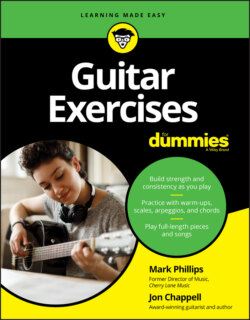Читать книгу Guitar Exercises For Dummies - Jon Chappell - Страница 28
Single-note exercises
ОглавлениеSingle-note exercises have the advantage of getting your left-hand fingers moving one by one, which helps them to fret accurately and has you warming up with the same type of motion you use to play scales, arpeggios, and their corresponding sequences. The following figures show four exercises that each get the fingers moving in slightly different ways. You can play these exercises with a pick or with your right-hand fingers.
Figures 2-1 through 2-4 show exercises based on left-hand finger patterns that repeat for each string. The two types of movements in these four figures require going across the neck (which means you don’t change positions) and diagonally (which means you change positions by going up the neck while also going across).
Because these are exercises for the fingers, there’s nothing musically meaningful about them. They’re all just about the pattern. So here’s a hint: Look only at the tab to see the patterns more easily.
Practice the warm-up in Figure 2-1 using your 1st, 2nd, 3rd, and 4th fingers to play the first four frets on each string. Moving along the string one fret at a time, in half steps, is known as playing chromatically.
FIGURE 2-1: “Across the neck” chromatic warm-up.
Figure 2-2 shows a warm-up with a diagonal pattern. This pattern requires a shift, or a move up to a new position. Play the first four notes with the first four fingers as you do in the previous warm-up. But on the fifth note, which begins at the 2nd fret on the 5th string, start with the 1st finger so you’ll be in 2nd position and can play frets 2, 3, 4, and 5 with fingers 1, 2, 3, and 4. On the 4th string, play frets 3, 4, 5, and 6 with fingers 1, 2, 3, 4, and so on. Here’s a simple way to think of it: Start each new string with the 1st finger.
FIGURE 2-2: Diagonal chromatic warm-up.
Figures 2-3 and 2-4 show warm-up exercises that are variations on the across and diagonal movements presented in the previous two figures. Figure 2-3 places a fret in between each played note (two frets equals a whole step; thus the name “whole step warm-up”). You have to stretch a bit to play these notes, but that stretch is part of the warm-up process. Remember the battle cry of personal trainers everywhere when your fingers start to burn: “No pain, no gain.”
Figure 2-4 takes the whole-step stretch presented in Figure 2-3 and applies it to diagonal movement.
FIGURE 2-3: “Across the neck” whole step warm-up.
FIGURE 2-4: Diagonal whole step warm-up.
